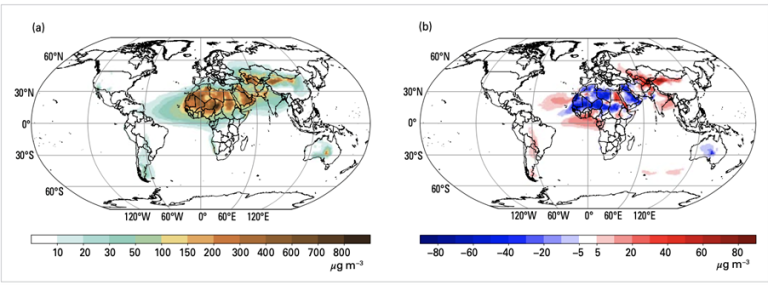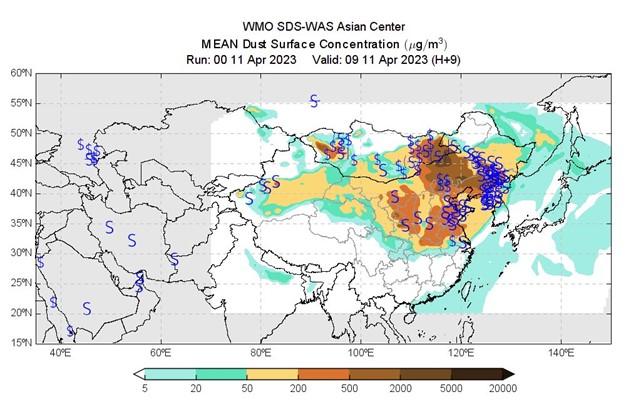WMO Bulletin spotlights hazards and impacts of sand and dust storms
The World Meteorological Organization (WMO) has issued its annual report on the incidence of sand and dust storms, as well as their impacts on society. Dust concentrations in the worst hit areas in 2023 were above the long-term average, but slightly lower than 2022, it says.
- Sand and dust storm activity in 2023 above long-term average
- Sand and dust storms have major environmental, economic and health impacts
- Poor land and water management aggravate the problem
- Improved monitoring and forecasting strengthens early warnings

The most severe storm of the year swept across Mongolia in March 2023, affecting more than 4 million square kilometres, including 20 provinces in China, according to the Airborne Dust Bulletin. It was released for the International Day of Combating Sand and Dust Storms on 12 July.
Every year, around 2,000 million tons of dust enters the atmosphere, darkening skies and harming air quality in regions that can be thousands of kilometers away, and affecting economies, ecosystems, weather and climate. Much of this is a natural process, but a large part of it is the result of poor water and land management.
“We need to be vigilant in the face of continuing environmental degradation and current and future climate change. Scientific evidence shows that human activities are having an impact on sand and dust storms. For example higher temperatures, drought and higher evaporation lead to lower soil moisture. Combined with poor land management, this is conducive to more sand and dust storms,” said WMO Secretary-General Celeste Saulo.
Monitoring and forecasting accuracy has improved in recent years due to the progress of numerical models and observation systems. The WMO Sand and Dust Storm Warning Advisory and Assessment System (SDS-WAS), set up in 2007, strives to improve warnings through dedicated regional centres and combines research and operational work.
“The Early Warnings for All initiative seeks to bring all hazards under one umbrella, including improved warnings and impact based forecasts of sand and dust storms,” said Celeste Saulo.
It is not all bad news. The long-range transport of sand and dust across oceans is also a valuable source of nutrients and important for the international management of fisheries.
Hotspots
The global average of annual mean surface dust concentrations in 2023 was slightly lower than that in 2022, mainly due to reduced dust emissions from several dust-active regions around the world, such as North Africa, the Arabian Peninsula, the Iranian Plateau, northern India, central Australia and north-western China.
But annual mean surface dust concentrations over western Central Asia, north-central China and southern Mongolia in 2023 were higher than those in 2022, according to the Bulletin.
The concentration of an air pollutant is given in micrograms (one-millionth of a gram) per cubic meter air or µg/m3. Spatially, the estimated peak annual mean surface dust concentration was located in some areas of Chad in North-Central Africa, at about 800–1 100 µg m3. In the southern hemisphere, dust concentrations reached their highest level in parts of central Australia and the west coast of South Africa.
Wind-driven dust aerosols may be transported from these typical dust source areas to many regions worldwide over hundreds to thousands of kilometres. The regions that are most vulnerable to long-range transport of dust are the northern tropical Atlantic Ocean between West Africa and the Caribbean, South America, the Mediterranean Sea, the Arabian Sea, the Bay of Bengal and central-eastern China.
In 2023, the transatlantic transport of African dust invaded parts of the Caribbean Sea region, and East Asian dust aerosols from the Gobi Desert also continued to reach the Bohai and Yellow Seas.
In the most affected areas, the annual mean surface dust concentration in 2023 was higher than the climatological mean. Hotspots included South America; parts of North and Central Africa.

Major storms in 2023
East Asia
During March to May 2023, East Asia was affected 13 times by intense dust intrusions. From 19 to 24 March, a massive dust storm swept across Mongolia and northern China, triggered by a cyclone over Mongolia and intensified by a cold surface wind, leading to widespread sand lifting.
The storm’s progression from west to east resulted in a rapid spread of sand and dust, affecting Mongolia and China, and even reaching the Republic of Korea and Japan. It caused a dramatic decline in air quality, with PM10 (particulate matter with diameters of less than 10 µm) concentrations in some areas exceeding 9 000 µg m–3. It reduced visibility to less than 500 m in parts of Beijing and led to significant disruptions in transportation and daily life, highlighting the need for effective warning systems.
Sahel and Gulf of Guinea
Strong and persistent dust outbreaks attributed to Harmattan surges began in the autumn of 2023 and recurred throughout the winter, affecting air quality and reducing visibility with significant impacts in the region.
In December 2023, several intense dust outbreaks affected an extensive region of the western Maghreb, the Sahel and the Gulf of Guinea and was also transported over the Atlantic.
Eastern Caribbean and northern South America
The winter and early spring period of December 2023 to April 2024 saw a number of Saharan dust intrusions.

Dust and oceans
There are, however, some positives.
The WMO Bulletin quotes a new study that Saharan dust deposition in the open waters of the Atlantic influences skipjack tuna by providing iron, phosphorus and elements that favour the growth of phytoplankton. The resulting new organic matter is transferred across the food web, from small fishes to large predators, favouring the whole marine ecosystem. The role of dust is important for the international management of fisheries.
From the 1950s to the 2020s, yearly catches of Atlantic skipjack have increased from less than 1 000 tonnes to average levels of 250 000 tonnes. During the 1990s and 2000s skipjack catches were about eight times higher in the eastern than in the western Atlantic. Indeed, in the last decade catches in the eastern Atlantic have accounted for nearly 90% of total Atlantic catches, data that highlight the large skipjack biomass off Western Africa, supported by dust fertilization.
The WMO Sand and Dust Storm Warning Advisory and Assessment System (SDS-WAS)
The Airborne Dust Bulletin discusses advances and challenges in dust forecasts, including assimilation of satellite observations and seasonal dust forecasting.
More than 25 organizations currently provide daily global or regional dust forecasts in different geographic regions, including 9 global models and more than 15 regional models contributing to SDS-WAS. The SDS-WAS integrates research and user communities (e.g. medical, aeronautical, agricultural users).
At the moment three Regional Nodes are established: the Northern Africa-Middle East-Europe Node (with the associated centre in Barcelona, Spain), the Asian Node (with the centre in Beijing, China) and the Pan-American node (with the centre in Bridgetown, Barbados).
In 2023, WMO SDS-WAS welcomed the Gulf Cooperation Council (GCC) Regional Node and its associated Regional Center in Jeddah. The Jeddah Regional Center is hosted by the National Center for Meteorology of Saudi Arabia.
The GCC Regional Node started with six countries in the region (Bahrain, Saudi Arabia, Kuwait, Oman, Qatar and United Arab Emirates). It promotes capacity building in the region providing a platform to gather and unite experts, scientists and policymakers under a common goal. Promoting regional collaboration will progressively build a path toward sustainable solutions and enhanced regional resilience in the region.
The World Meteorological Organization (WMO) is a specialized agency of the United Nations responsible for promoting international cooperation in atmospheric science and meteorology.
WMO monitors weather, climate, and water resources and provides support to its Members in forecasting and disaster mitigation. The organization is committed to advancing scientific knowledge and improving public safety and well-being through its work.
For further information, please contact:
- Clare Nullis WMO media officer cnullis@wmo.int +41 79 709 13 97
- WMO Strategic Communication Office Media Contact media@wmo.int

